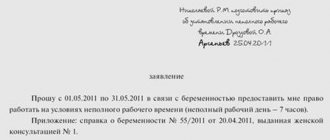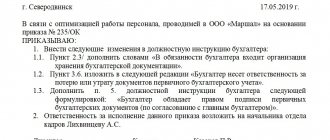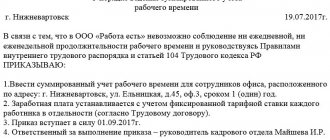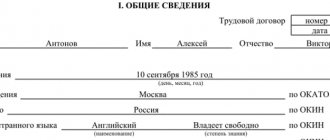Components
There is no established and correct form of order for all cases. The text can be formulated in free form.
Nevertheless, there are a number of conditions and necessary parts, without which the document loses its legal force. The provided samples and form contain all the necessary points. If desired, they can be expanded and supplemented in accordance with specific conditions of use.
The elements of the document are as follows.
- A cap. The order begins by indicating the name of the organization and its details. Some companies have personal forms on which this data is written. They will come in handy. Also at the top, in the middle of the sheet, are the name, date of adoption and document number.
- Main part. It includes:
- Motivation. This could be a reference to local acts, a changed legislative framework, or simply the phrase “In connection with...”.
- List of changes in the text of the regulation. It is advisable to resort to quotations and state in detail what text is being replaced and with what.
- The date on which the document comes into force.
- List of persons who should be familiarized with the order. If necessary, all employees of the organization.
The document is completed by the signature of the manager, the seal and the signatures of all those familiar with it (if such was the wording).
Types of agreement additions
Changes and additions that are accepted by both parties can be formalized by means of a conclusion:
- additional labor agreement;
- applications;
- in a different form.
Once concluded, they come into force from the moment of signing or from the date specified in the agreement.
A form such as an additional agreement is a form of consolidation of changes that arise in labor relations. Not all changes can use a form such as an additional agreement.
When choosing this form, it is important to follow the rules for drawing up such a document, which will help to avoid fines and conflict situations.
https://youtu.be/ijx5mvS1mUM
How things can change
There can be as many wage regulations as there are organizations. This document is a local regulatory act that is adopted by each organization separately. And it can also be edited at the discretion of the manager.
Naturally, when making changes, the norms of the labor code and other laws must be observed. In addition, employees must also agree to accept the changes that are planned to be made. So, the text of the provision may change as follows:
- A paragraph, paragraph or subparagraph may change completely. In the text of the order, this can be read as “Clause 2 shall be stated in the following wording...”.
- Be supplemented by a paragraph, subclause or entire clause of the agreement.
- A piece of text (clause, chapter, paragraph, subclause, etc.) may lose its power completely. It is simply not spelled out in the new version of the regulations.
Additional details
Since the document is freely worded, it can, if necessary, be supplemented with such details as:
- Full name of the person responsible for familiarizing all employees with the order. This can be either a purely nominal function (after all, 2 months before, all interested parties were familiarized with the upcoming changes), or an unpleasant responsibility of the employee (if the staff is large and the changes affected many employees who did not pay attention to the initial warning).
- Tables. It is convenient to do this when formulating changes that affect the rates and salaries of a number of employees at once.
- From what time does the order apply to legal relations? Sometimes it is important to indicate this information. For example, for the normal functioning of the accounting department (the accountant has questions regarding the dates of payment of salaries, bonuses, etc.).
- Who is responsible for carrying out the order?
Nuances
Article 44 of the Labor Code separately stipulates the rules by which the provisions on remuneration are changed if it is attached to a collective labor agreement.
If the provision is an independent document, then it can be changed only on the basis of Article 372 of the Labor Code.
The latter states that before making changes, the manager must discuss his decision with the elected body of the primary trade union organization (at large enterprises, if any). However, in practice this does not happen often. In the absence of a trade union organization, the decision to change is made by the manager alone. Moreover, even if the boss has a protocol of disagreements submitted by the trade union, he can still accept a new version of the wage regulations. Moreover, he can do this in two ways:
- Issue a separate document - an order to amend the Regulations on remuneration with mandatory notification of employees against signature;
- Accept (approve) the new edition of the Regulations and certify it.
In the latter case, it is also necessary to notify employees, but in other ways.
At this point, the rule applies: if the Regulations were adopted by order of the manager, then they must be changed by issuing and signing an order. If the Regulations were approved by stamping “Approved,” then no order needs to be issued. In this case, it is necessary to completely rewrite the document with changes and accept its new edition.
Deadlines for notification of changes to the employment contract
According to the Labor Code (in particular, Article 74), if an employer plans to make significant changes to the terms of an employment contract with an employee (and the provisions on remuneration may overlap with it), then the subordinate must be informed about this at least 2 calendar months in advance. A separate annex is attached to each employment contract, informing about the changes made.
For insurance purposes, it is better to obtain written confirmation of consent to make changes. Otherwise, the employee can declare his rights in the event of a conflict, go to court and win the case. Proof of notice in writing is a guarantee of peace of mind for the employer.
If the employment contract of an employee (or several) did not clearly state the changeable conditions, but there was only a reference to the Regulations on Remuneration, then they do not need to be changed. However, in case of significant changes, the obligation to notify 2 months in advance still remains.
The procedure for changing the method of managing an apartment building and selecting a management organization
Created: November 08, 2019
The method of managing an apartment building is chosen at a general meeting of owners of premises in the apartment building, and can be chosen and changed at any time based on its decision. The decision of the general meeting on the choice of management method is mandatory for all owners of premises in an apartment building.
Owners of premises in an apartment building are required to choose one of the methods of managing an apartment building: direct management of the owners of premises in an apartment building, the number of apartments in which is no more than thirty; management of a homeowners' association or housing cooperative or other specialized consumer cooperative; management of the management organization.
If the owners have implemented a management method - management of a management organization, then the agenda of the general meeting should include the issue of terminating the contract with the management organization and choosing another management organization or changing (choosing) the method of managing the house (Part 1 of Art. 44 Housing Code of the Russian Federation).
The management agreement for an apartment building is amended and (or) terminated in the manner established by civil legislation (Part 8 of Article 162 of the Housing Code of the Russian Federation). Civil legislation allows unilateral amendment and termination of a contract if this is provided for by law or contract. In case of unilateral refusal of the contract, when such refusal is permitted by law, the contract is considered terminated (clause 4 of article 450, clause 2 of article 450.1 of the Civil Code of the Russian Federation).
The owners of premises in an apartment building unilaterally have the right to refuse to execute a management agreement for an apartment building, concluded as a result of an open competition, after each subsequent year from the date of conclusion of the said agreement, if, before the expiration of the agreement, the general meeting of owners of premises in the apartment building made a decision on choosing or changing the method of managing this house (part 4 of article 161, part 8.1 of article 162 of the Housing Code of the Russian Federation).
The owners of premises in an apartment building are given the right to unilaterally refuse to execute a management agreement for an apartment building if the management organization does not comply with the terms of such an agreement, and decide to choose another management organization or change the method of managing this building (Part 8.2 of Article 162 of the Housing Code of the Russian Federation ).
If the owners unilaterally terminate the house management agreement with the management organization, the obligations of the parties are terminated, unless otherwise provided by law, agreement or follows from the essence of the obligation (Clause 2 of Article 453 of the Civil Code of the Russian Federation).
To terminate the contract with the management organization, the owners of the premises must hold a general meeting of the owners of the premises, it should be noted that the meeting is valid (has a quorum) if the owners of the premises in the house or their representatives with more than 50% of the total votes took part in it (Clause 4, Part 2, Article 44, Part 3, Article 45, Part 1, Article 46 of the RF Housing Code). If the meeting has taken place, within five days a notice of the decision made at the meeting (termination of the contract), with a copy of the decision attached, must be sent to the organization that previously managed the house and to the state housing supervision body (municipal housing control body).
As mentioned earlier, the owners of premises in an apartment building independently choose the method of managing this building, one of which is the management of a management organization. At the same time, the management must ensure favorable and safe living conditions for citizens, the proper condition of the common property of apartment buildings, resolving issues of use of common property, as well as the provision of public services or, in some cases, the readiness of communications and equipment for the provision of public services (parts 1, 2 of Art. 161 Housing Code of the Russian Federation).
In order to select an apartment management company, we recommend, first of all, to determine a list of possible management companies. A management company is a commercial organization that provides management services for an apartment building on the basis of a license. An apartment building can be managed by only one management organization (Part 1.3, 9, Article 161 of the Housing Code of the Russian Federation).
To assess the activities of a particular management company, it is possible to use the information posted in the state information system of housing and communal services. The list of management companies can also be posted on the official websites of local governments.
The method of managing an apartment building and a specific management company are selected at a general meeting of owners of premises in an apartment building (hereinafter referred to as the general meeting) (Part 1, Clause 4, Part 2, Article 44, Part 3, Article 161 of the Housing Code of the Russian Federation). A decision can be made at the annual general meeting or an extraordinary meeting can be convened for this purpose, the initiator of which can be any of the owners (Part 2 of Article 45 of the Housing Code of the Russian Federation).
The decision on the choice of method of management of apartment buildings is made by a majority of votes from the total number of votes taking part in this general meeting (Part 1 of Article 46 of the Housing Code of the Russian Federation).
The number of votes of each owner is determined in proportion to his share in the right of common ownership of common property in an apartment building (Part 3 of Article 48 of the Housing Code of the Russian Federation).
When holding a general meeting through in-person, in-person, absentee or absentee voting, the owner’s decision must indicate (Part 5.1, Article 48 of the RF Housing Code):
1) information about the person participating in voting;
2) information about the document confirming the ownership of the person participating in the vote to the premises in the corresponding apartment building;
3) decisions on each issue on the agenda, expressed in terms of “for”, “against” or “abstained”.
In this case, the owner does not have the right to take part in the general meeting with only part of his votes.
The decision of the general meeting is documented in minutes. The person on whose initiative the general meeting was convened submits the originals of the decision and minutes to the management organization no later than ten days after the general meeting of owners (Part 1 of Article 46 of the Housing Code of the Russian Federation).
After the general meeting makes a decision on choosing a management company, a management agreement is concluded with each owner on the terms specified in the decision of the general meeting. The owners of premises in this building, having more than 50% of the votes of the total number of votes of the owners of premises in this building, act as one party to the concluded agreement. At the same time, each owner of premises in an apartment building independently fulfills his obligations under the management agreement, including the obligation to pay for residential premises and utilities, and is not responsible for the obligations of other owners.
Under the terms of the agreement, the management organization, within an agreed period of time for a fee, undertakes to perform work and (or) provide services for the management of an apartment building, for the proper maintenance and repair of common property in such a house, to provide utilities to the owners of the premises and persons using the premises in this building, or to provide readiness of engineering systems, as well as to carry out other activities aimed at achieving the goals of managing an apartment building (Parts 1, 2 of Article 162 of the Housing Code of the Russian Federation).
Based on the decision of the general meeting, the owners of premises in an apartment building have the right to unilaterally refuse to fulfill the contract if the management organization does not fulfill its terms, and decide to choose another management organization or change the method of managing the apartment building (Part 8.2 of Article 162 of the Housing Code of the Russian Federation) .
Comments
- Comments
- In contact with
Add a comment
JComments
Download SocComments v1.3
General procedure for making changes to LNA
Any local regulation requires periodic amendments. The reasons for this are varied. The most common reasons for making amendments are errors in the document, changes in legislation, and internal reform of rules in the organization. For example, changes to the wage regulations may be required in connection with the establishment of different dates for payment of wages.
The legislation does not establish the procedure for making adjustments to the LNA. Let's look at how to make changes to the organization's regulations.
You can make adjustments to existing acts in one of two ways:
- issue an order or order to make adjustments;
- draw up the LNA in a new version and approve it.
The employer himself chooses which way to do this. If the amendments are single, for example, only the salary payment dates change, then it is more convenient to make adjustments by order.
If there are many adjustments, then it will be more rational to approve the act in a new edition.
Under what conditions is document editing allowed?
Employers must take into account the grounds and procedure for changing the employment contract. Therefore, company leaders must have compelling reasons to undertake this process. They are listed in Chapter 12 of the Labor Code. Therefore, the correct procedure for changing an employment contract can be carried out on the following grounds:
- Employee transfer. It may involve sending a specialist to another branch or transferring to another position on the initiative of the company management. This leads to a radical change in the specialist’s work functions. He is forced to work in completely different working conditions. The procedure for making changes to an employment contract under such conditions requires obtaining consent from the employee for the transfer. This process is not a relocation, since the employee’s job functions completely change.
- Adjustment of conditions that were previously agreed with the employee.
- Change of business owner or company reorganization.
- Removal of an employee from his official duties for various reasons.
Other reasons may also be considered grounds for adjusting the contract. The procedure for concluding and amending an employment contract is enshrined in legislation. Therefore, if it is not observed by company managers, then they are considered violators of the Labor Code.
By law, the parties can adjust absolutely any clauses of the agreement if an appropriate agreement is reached between them. The most common changes are the duration of the contract or the name of the company, the amount of earnings of a specialist or his position.
Changes to position
The document on making corrections to the LNA must contain:
- justification for the amendments made;
- list of adjustments made;
- the date from which the document comes into force.
Since changes are being made to the provisions relating to the regulation of labor relations, and if the LNA was adopted taking into account the opinion of the representative body of workers (trade union), then adjustments to it can only be made taking into account the opinion of this body (Article 372 of the Labor Code of the Russian Federation).
Procedure for changing agreements
Changes are made to the agreement (industry, concession, etc.) in the manner established for its conclusion. It is assumed that the following order of changes to the document can be used:
- through collective bargaining, during which an appropriate agreement is reached;
- changes can also be made in the manner established by the agreement itself.
The application of a certain procedure directly depends on the nature of the changes, urgency and other circumstances that arise during the validity of the agreement.
When promoting change through collective bargaining, the following procedure may be used:
- the party initiating the changes must formulate them properly, providing arguments in their favor;
- the prepared document is sent to the other party who took part in concluding the agreement, and the second party must give a reasoned response within 7 working days from the date of receipt of the notification;
- if the second party refuses to accept the changes, the first has the right to refuse its proposal or continue to insist on it;
- the final decision in case of refusal by one of the parties is made by the conciliation commission.
The parties can determine how changes will be made independently. For example, it may be stipulated that changes to an industry or concession agreement are made by agreement of the parties after consultations have been held or if there is a decision by the industry commission to conduct joint negotiations.
The procedure for making changes to the wage regulations
Is it possible to make changes to the wage regulations? Yes, you can. This document is subject to change at the discretion of the organization's management.
How to correctly make changes to the salary regulations
Corrections to the salary document must be executed in the same way as the original document itself was approved. If this regulation was approved by a decree or order, then a corresponding decree or order is issued to make corrections.
An order to change the wage regulations is issued in the same way as any order to adjust the LNA. It must indicate the reasons for the changes being made, list the corrections being made, and set the start date for the order.
If the regulations were approved by using the stamp “Approved”, then corrections should be made to them by issuing the provisions in a new edition.
Since it is much easier to formalize changes to the regulations by order in the case of single corrections, employers often use this option.
What information is indicated in the order?
There is no legally approved form for this order. In this regard, the director of the organization has the right to determine it independently. However, there are certain requirements for the design of this document. It should indicate:
- name of company;
- Title of the document;
- date and order number;
- wording with the name of the local act being put into effect;
- date of entry into force of the document;
- information on the timing of familiarization of employees with the local act;
- FULL NAME. and the position of the employees who are responsible for compliance with the document;
- other conditions;
- signature of the head of the company.
After the publication of the document, salary rules regarding settlements with company personnel come into force.
Order on wage regulations, sample 2020
Order on remuneration of workers, sample 2020, free download
What to pay attention to
A wage regulation is a legal regulation that establishes rules for remuneration of workers. Therefore, all amendments to it are made in accordance with labor legislation. If this regulation is an annex to the collective agreement, amendments to it are made in accordance with Art. 44 of the Labor Code of the Russian Federation - taking into account the opinion of the employee representative. If the regulations are a separate document, then corrections are made to it in accordance with Art. 372 of the Labor Code of the Russian Federation - taking into account the opinion of the trade union organization. That is, the employer, in any case, must notify the other party about the amendments being made and obtain consent to this or draw up a protocol of disagreements for their further resolution.
Any amendments made to the LNA must not change the position of employees for the worse, compared to legislative norms, and must comply with current legislation. At the same time, it is possible to improve any conditions. For example, changes to the wage regulations can be made to increase the amount of additional payment for night work (according to the Labor Code of the Russian Federation - 20%, and the LNA can establish an additional payment of 50%).
It is necessary to inform employees about any adjustment made to the LNA (Article 22 of the Labor Code of the Russian Federation).
Making an order
The order must be issued on the institution's letterhead. It should contain the following:
- information about officials involved in the development of the draft changes;
- information about the responsible employee;
- information about the officials with whom the changes will be coordinated (if they exist in the organization);
- timing of development and approval of adjustments;
- date of approval of the changes and additions made.
Order on amendments to the Internal Labor Regulations (sample)
Each employee must be familiar with the adjustments upon signature. This will mean that employees know the new Rules that they must comply with. To confirm that employees are familiar with innovations, a special journal or form is used.
Expert commentary
Leonov Victor
Lawyer
An important nuance is the nature of the changes made to the local act. If they relate to points specified in the employment contract concluded with the employee, then additional documents must be completed.
For example, an organization's operating mode changes. Employees must be notified of this no later than 2 months before the introduction of the planned changes. In this case, there must be an important justification for new organizational or technological conditions. According to labor laws, employees who do not agree to this work schedule must be offered other duties if possible. If this is not possible, you can part with the employee on the basis of clause 7 of Art. 77 TK.
Article 77 of the Labor Code of the Russian Federation
“General grounds for termination of an employment contract” (more details)
When changing the work schedule or other clauses of the employment contract, an additional agreement must be concluded with the employee. It sets out new working conditions. The employee’s signature on the document means that he agrees with the changes and will adhere to them.
Amendments to the Internal Labor Regulations are made as to other local legal acts of the organization. The employer must issue an order regarding the changes and familiarize all employees with them. If the Rules are only an annex to the Collective Agreement, the adjustment procedure will be different. Any changes are accepted only after their consideration by a commission, which includes representatives of the administration, trade union and labor collective.
Do I need to notify employees?
Corrections to the wage regulations must occur in accordance with the procedure established by law:
- if the amendments concern the terms of the employment contract, the consent of the employees is required (Article 72 of the Labor Code of the Russian Federation);
- if corrections are made due to organizational or technological changes in the employee’s working conditions, the employer makes them unilaterally, warning the employees in writing 2 months in advance (Article 74 of the Labor Code of the Russian Federation).
If the amendments to the regulations do not concern the mandatory terms of the employment contract, for example, the positions of the persons mentioned in the document have been renamed, then the consent of the employees to these amendments is not necessary.
Additions to the wage regulations are drawn up in the same manner.
Questions and answers on the topic
Form and content
The labor legislation does not have an approved sample of an employee’s notification of changes in wages, so we recommend that you draw up the document yourself in free form and, in accordance with Part 2 of Art. 74 of the Labor Code of the Russian Federation, indicate in it:
- reasons for switching to a new system and why the old one cannot be preserved;
- what exact changes will occur in payment for work (you can quote specific provisions of the document that established the new wage payment system);
- from what date will the organization apply the new payment scheme;
- what will happen, in accordance with Art. 74 of the Labor Code of the Russian Federation, if the employee agrees or refuses to work under new conditions.
Question
The organization has a local regulatory act - Regulations on bonuses for department employees. One of the paragraphs defines the range of positions to which this Regulation applies. We have a new position (we are hiring a person) and we need to include this position in the list of bonuses. Question: how to correctly make changes to the Regulations? Is it enough to issue an order to make changes and inform only the new employee who is directly affected? Or should the Regulation itself be reissued? And in this case, familiarize all employees again? And so with every change? (for example, adding new positions). Thank you for your answer!
How are changes made if the initiator is an employee?
Situations often arise when a direct employee of a company wants some amendments to be made to his employment contract. In such conditions, the correct procedure for amending and terminating an employment contract must be followed. Therefore, the following steps are performed:
- the employee draws up a statement where he asks the manager to make certain amendments to the employment contract;
- reasons for such changes are given;
- the application is registered by the company management, after which the specialist needs to wait for a response;
- if the answer is positive, then an agreement is drawn up between the parties, on the basis of which the contract is edited;
- this agreement is registered with the company based on the requirements of the enterprise’s internal regulations;
- the agreement is signed by both participants in the process;
- an order is issued to amend the document;
- the employee gets acquainted with this document, after which he puts his signature on the order.
Violation of this process is not permitted. If the competent procedure for changing and terminating an employment contract is violated, this is a serious offense.









